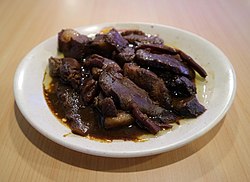Babi hong
 Babi hong, a Chinese Indonesian pork belly dish in Chinese sauces and seasonings. | |
| Course | Main course |
|---|---|
| Place of origin | Indonesia |
| Region or state | Chinatowns in Indonesia |
| Created by | Chinese Indonesians |
| Serving temperature | Hot |
| Main ingredients | Pork belly braised in soy sauce, garlic and Chinese sauces |
| Similar dishes | Babi kecap, red braised pork belly |
Babi hong is a Chinese Indonesian pork belly dish possibly of Hakka origin.[1] The samcan or pork belly is boiled or braised, fried and steamed in numbers of Chinese seasonings and sauces.[2]
Babi hong is often offered in Chinese Indonesian restaurants, especially in Chinese towns in Indonesian cities.[3] Traditionally this dish is considered as a special dish to be served to guests and family during special occasion such as imlek (Chinese New Year).
Babi hong is quite similar to other Chinese Indonesian pork dish – babi kecap (pork braised in soy sauce), although babi kecap is a much simpler dish. It is quite similar – possibly related to Hakka dish kiu nyuk and mainland Chinese pork belly dish hong shao rou.
Ingredients
[edit]The main ingredient is samcan or pork belly meat, hioko or shiitake mushroom, sayur asin or dried salted mustard greens, with garlic, ginger, salt, sugar, pepper, and ngohiong or five-spice powder. For seasoning this dish uses three types of soy sauces; common salty soy sauce, kecap manis (sweet soy sauce), and kecap jamur (black mushroom soy sauce). It also uses angciu (Chinese red cooking wine) and oyster sauce.[1] The pork belly actually must undergo three stages or three types of cooking methods; including boiling or braising, frying in oil, and steaming.[2]
See also
[edit]References
[edit]- ^ a b "Resep Babi Hong ala Hakka". Cookpad (in Indonesian). Retrieved 18 March 2021.
- ^ a b Az-Zahra, Zafira. "Yuk Coba Bikin Resep Babi Hong yang Mantul Abis!". IDN Times (in Indonesian). Retrieved 2021-03-18.
- ^ Tjhia, Syilvia. "Review di Angke Restaurant, Gajah Mada". PergiKuliner (in Indonesian). Retrieved 2021-03-18.
External links
[edit] Media related to Babi hong at Wikimedia Commons
Media related to Babi hong at Wikimedia Commons- Home made babi hong recipe in Youtube
- Simplified babi hong recipe in Youtube
